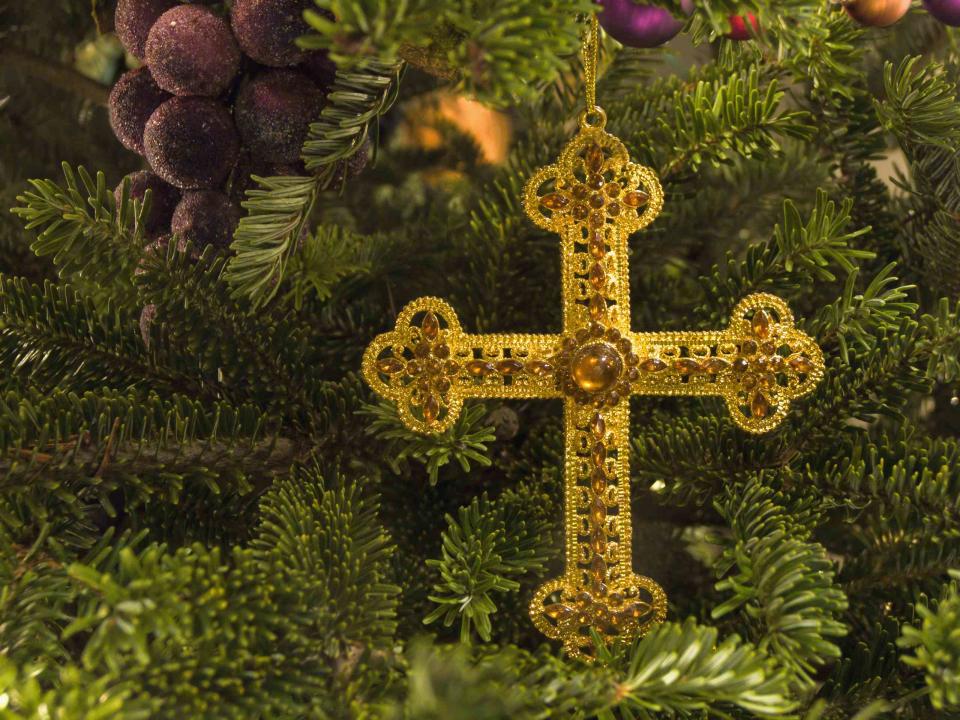The Tradition Behind The Chrismon Tree
There’s no shortage of meaningful ornaments in the South, but a tree decorated in Chrismons tells the greatest story of all.

Getty Images
Christmas trees can take many forms. They might be dripping in glass icicles, covered in tinsel, or feature a pickle tucked in between the branches. But one thing remains the same with just about any Christmas tree you find from Virginia to Georgia, Florida to Texas: It has meaning. Whether that comes in the form of passed-down ornaments, each with their own story to tell, or special techniques for decorating because that’s what Mama always did, Southerners aren’t ones to shy away from tradition, particularly when it symbolizes far more than meets the eye.
While Christmas trees oftentimes have meaning well beyond their beauty, there’s one variety that serves as a herald, pointing to the reason for the season. The Chrismon tree is a relatively new tradition, though its ornaments, or Chrismons, go way back.
History of the Chrismon Tree
The word “Chrismon” draws from the words “Christ” and “monogram,” translating to “symbols of Christ.” Historically, there have been times when Christians were not free to worship in public, or even acknowledge their faith. These symbols were a way for the followers of Christ to recognize their faith in a more covert way. For example, a symbol like a fish might be used in an underground passageway to point toward a place of worship so visitors would know where to go or simply mark that they were among friends.
In 1957, Mrs. Harry W. Spencer of the Lutheran Church of the Ascension in Danville, Virginia, was inspired to use these Christian symbols, or Chrismons, in lieu of colorful balls and non-religious décor on her church’s Christmas tree. Today you’ll find Chrismon trees used in the nave of many churches throughout the country and even the world during the Advent and Christmas seasons.
Making Chrismon Tree Ornaments
Traditionally the ornaments found on Chrismon trees are handmade, though you can find ready-to-go options via retailers like Amazon and Etsy. Part of the beauty in the tradition though, seems to be taking the time to select the symbols and create the ornaments. For those who take part, it can be a labor of love that prepares hearts and builds anticipation for the Advent season and birth of Christ.
The ornaments decorating a church Chrismon tree are oftentimes made by members of the congregation and can be built upon each year. Materials can be as humble as Styrofoam, paper, or bleached wood though beads, white glass ornaments with gold symbols, and cross-stitched pieces are all popular choices. Preparation for the church’s Chrismon tree might be a year round project, but it usually always culminates by assembling the tree in time for the first week of Advent.
Chrismon tree ornaments and symbols can not only point to the Christian faith, but can also be a reminder of generations that came before. Similar to handmade cross-stitched stockings, or vintage mercury glass orbs passed down from parents and grandparents, these white and gold treasures are a labor of love that can be a tradition that depicts not only the symbols of Christianity, but also the growth of faith whether in a family or larger church community throughout the years.
Why Chrismon Ornaments are Traditionally White and Gold
Every aspect of the Chrismon tree has significance, from the symbols on the ornaments to the colors they draw on. Chrismon trees are typically decked in all white and gold. The white symbolizes the perfection and purity of the Lord, while gold points to His nobility and glory. The tree’s white lights are a reminder to believers that He is the Light of the world and the evergreen symbolizes our own eternal life, a gift of Christ’s sacrifice for us.
Chrismon Tree Ornament Symbols
Chrismon tree ornaments are meant to serve as reminders of God’s gift of Jesus Christ, which mean all of the ornaments used on the tree hold special significance.
Popular Chrismon Tree Symbols
Star: There are a variety of star Chrismons, each with its own meaning. They range from the five-pointed star to the 8-pointed Natal Star Cross, with the former representing the five wounds of Jesus and the latter representing the Bethlehem star and the four New Testament gospels.
Triangle: A triangle represents the Father, Son, and Holy Spirit.
Cross: There’s a wide range of crosses used on Chrismon trees. Like the various stars, each cross delivers its own special meaning from the anchor cross, the Fleur-de-Lis cross, the Celtic cross, the Jerusalem Cross, and the Latin Cross—to name a few.
Dove: The dove is traditionally used as a symbol of the Holy Spirit.
Lamb: A lamb signifies Jesus Christ, the Lamb of God.
Fish: This was one of the original secret symbols used to identify followers of Christ and would be used to point in the direction of places of worship.
For more Southern Living news, make sure to sign up for our newsletter!
Read the original article on Southern Living.

